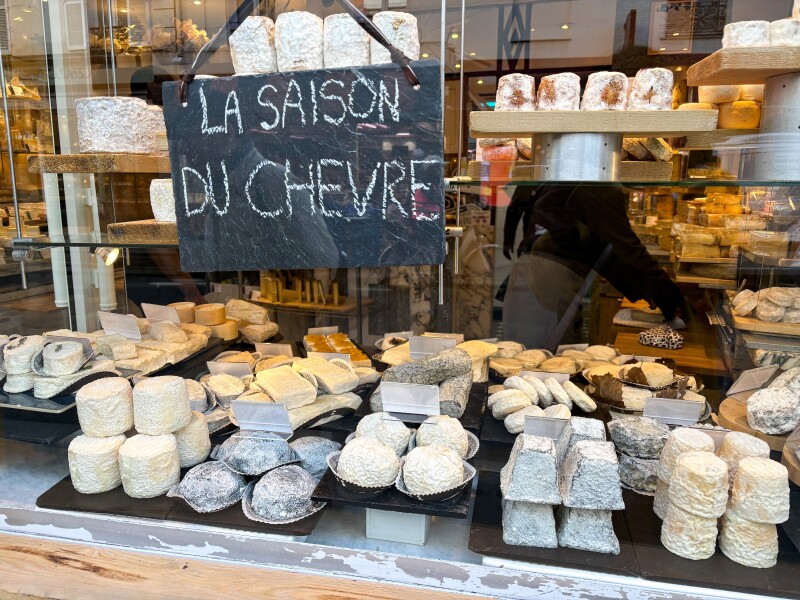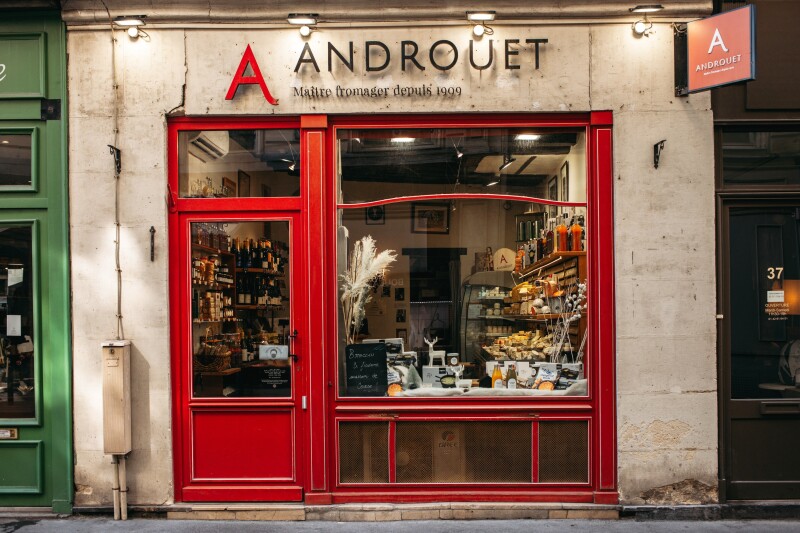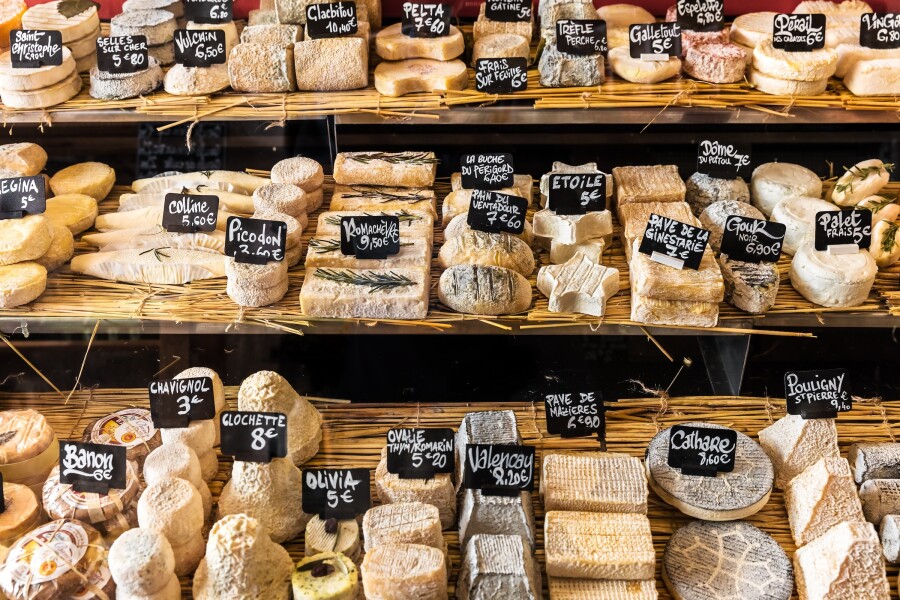France started making ridiculously good cheese more than 1,000 years before the United States even existed, starting with 7th-century Brie-mixing monks. The range of cheese available in France today is delightfully staggering—everything from intensely nutty and fruity Mimolette to Mont d’Or, a fall and winter soft washed-rind cheese, eaten baked and deliciously goopy.
Shopping at a fromagerie in Paris can be intimidating, but a love of cheese transcends boundaries, and most shopkeepers are more than pleased to help out a fellow enthusiast. If you go into your search with humility, curiosity, and these tips, you’ll leave with plenty of cheese to be enjoyed during picnics in Paris and your travels around France.
What makes French cheeses unique
Numerous French cheeses are not available in the United States, so going to a cheese shop in France can feel a bit like going to a museum. And the same rules apply: Look, don’t touch.
Many of the cheeses you do know and love will taste different in France due to different milk. U.S. law requires that all cheese younger than 60 days be made with pasteurized milk. The pasteurization process eliminates any potentially harmful bacteria from the milk, but it also eliminates some harmless bacteria that drive flavor in the cheese. That’s why U.S. cheese fans might think of Brie—which is almost always younger than 60 days and therefore pasteurized in the USA—as a mild cheese that tastes like butter. But the traditional raw milk (that is, unpasteurized) versions of Brie you can find in France taste more like garlicky roasted brussels sprouts or broccoli-cheese soup.
Even if you’re the cheese expert of your friend group, you may feel out of your depth in a Paris cheese shop. Remember to be open-minded about the unfamiliar. You may be horrified to spot blue mold on anything other than a Roquefort, but many French prefer a number of cheeses with a bit of blue mold, like Rochebaron, a soft, creamy round with a light ash crust, made in the Auvergne region. The mold is harmless and can add a peppery flavor much like arugula.
Because these young, delicious raw-milk cheeses tend to express a wider range of flavors than their pasteurized counterparts, you may find that some smell and taste more like a barnyard than you’re used to. That is often the desired flavor! You may love it, you may hate it, you may hate it the first time you try it and then grow to love it. However you feel, give it a chance.

It’s the season of goat cheese at this Paris shop.
Photo by P. Kheawtasang/Shutterstock
What kinds of cheeses to try in Paris
Some cheese nerds will focus on finding types in Paris that we can’t find in the United States, like the unpasteurized versions of Reblochon or Saint-Marcellin. That’s a good way to experience a host of new flavors, but make sure to also try cheeses that you think you’re familiar with, especially if they are labeled lait cru (raw milk). These will likely taste different than you expect.
Also look for the word fermier, which means farmstead. While it’s common for larger cheesemakers to buy milk from several small dairy farmers to make their cheese, a farmstead cheese is made only with the milk of animals that live on the farm that produces that cheese. Both raw milk and farmstead cheeses tend to have more variable, expressive flavors.
If you’re already a cheese aficionado, you know that different animal milks produce different flavors. In France, de chevre indicates a cheese made with goat’s milk, which tends to lend tang and minerality to the flavor. De vache, or a cheese made with cow’s milk, will probably taste the most familiar, but you’ll notice deeper, grassier flavors in the French versions of these cheeses than you’re used to. De brebis denotes a cheese made with sheep’s milk; it will be richer and more brothy or gamey.
As with produce, cheese is seasonal. Goats usually give birth in the early spring, and so that’s when they start giving milk. If you’re in Paris in the spring, you’ll find fresh and Brie-style goat cheeses at their peak, sometimes adorned with fresh flowers, herbs, and fruits.
In the winter, cows are often moved to a barn, where they switch from a diet of fresh grass to a diet of hay. They also make less milk during those months, but that milk is higher in fat and protein, so cheesemakers traditionally switch to a different recipe seasonally.

Exterior of small cheese shop in Paris
Photo by Yana Fefelova/Shutterstock
5 of the best cheese shops in Paris
- Androuet: Henri Androuet invented the concept of a modern cheese shop in 1909 with Androuet, and there are now seven locations of this fromagerie open throughout the city. They sell a huge range of cheese and its accoutrements—cornichons, jams and chutneys, crackers, and wine. The branches in the 7th and 16th arrondissements are open on Mondays—a rarity.
- Barthélémy: Nicole Barthélémy’s shop has been open more than 50 years and is known for stocking uncommon cheeses, such as Cathare, a goat’s milk cheese from the Languedoc-Roussillon region that comes in a charcoal-covered round. Ina Garten has said this is her favorite cheese shop in Paris.
- Fromagerie Laurent Dubois: There are several locations for the chic Fromagerie Laurent Dubois, and each has a slightly different feel. Be sure to try the Camembert Pomcalva, a Camembert made in Normandy that’s soaked in Calvados, giving it a lovely apple flavor.
- Chez Virginie: No surface has been left uncovered at Virginie Boularouah’s two incredible shops near Sacre Coeur, which sell 150 varieties of raw milk cheeses.
- Taka & Vermo: Co-owner Laure Takahashi is known for her unique and tasty Japanese-inspired cheese, like tiny rounds of goat cheese topped with confit yuzu, or Gruyère with sweet, cardamom-y woodruff leaves—plus wine, crackers, and tapenades. This small, well-curated shop is 10 minutes’ walk south of Gare de l’Est, so it’s an easy place to put together a train picnic.
French cheese shop etiquette
It bears repeating: Look, don’t touch. Consider the glass display cases filled with cheese to be works of art.
All of the above cheese shops have staff who speak English and are happy to make recommendations. Let them know of any cheeses you especially love or dislike and don’t be afraid to ask questions. The exception to this is if there’s a long line; then, you need to keep things moving.
Shopkeepers want to help their customers find their dream cheeses, and most are usually happy to cut samples to taste—as long as it doesn’t compromise the quality or shape of the cheese, as it could for single-serving cheeses or small wheels. All fromageries can vacuum seal cheese.
Once you’ve successfully purchased your cheese, get some crackers or swing by a nearby boulangerie for a baguette and a nearby caviste (wine shop); many wine shops also sell nonalcoholic drinks like pressed juices, kombucha, and alcohol-free beer. Treats in tow, go for a picnic in one of Paris’s myriad squares, along the Seine or Canal Saint-Martin or, for an Eiffel Tower view, the Champ-de-Mars.
This article was originally published in 2018 and most recently updated on July 23, 2024, with current information. Christine Clark contributed to the reporting of this story.











